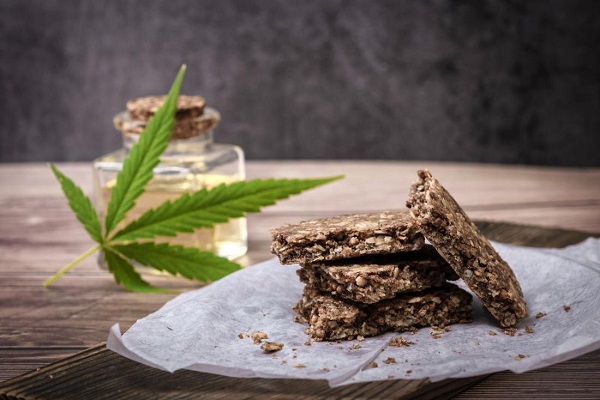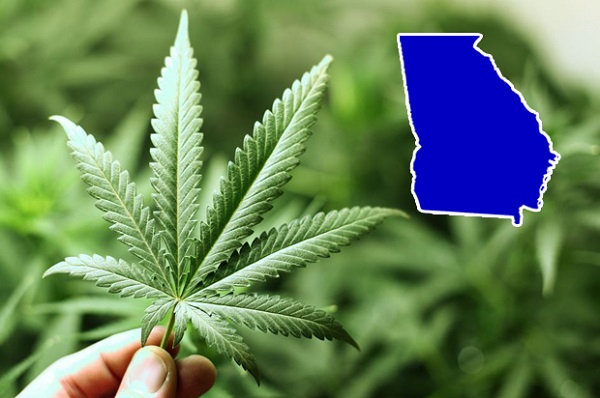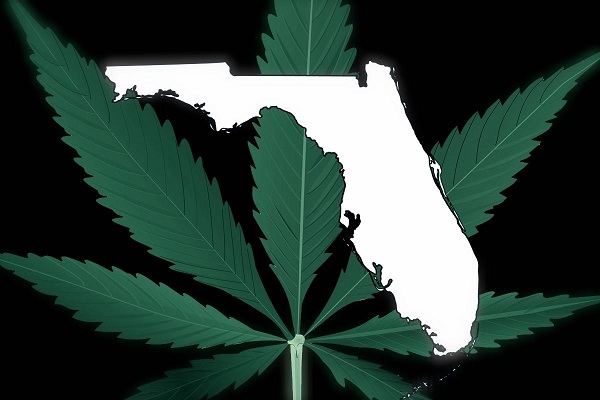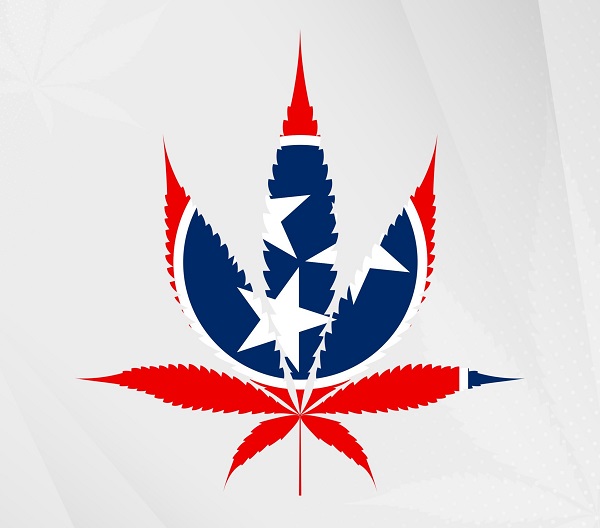Cannabis, an ancient plant with a complex chemistry, continues to captivate researchers and enthusiasts alike with its array of fascinating compounds and their potential effects on the human body. Among the numerous cannabinoids found in cannabis, Δ9-tetrahydrocannabinol (THC) has long been recognized as the primary psychoactive component responsible for the plant’s mind-altering properties. However, recent scientific investigations have shed light on another compound derived from THC that possesses remarkable pharmacological potential: 11-Hydroxy-THC.
While THC itself has garnered substantial attention, particularly for its therapeutic applications, the emergence of 11-Hydroxy-THC as a crucial player in cannabis pharmacology has sparked renewed interest and exploration. This metabolite arises from the metabolism of THC within the human body, offering unique effects that distinguish it from its parent compound. Understanding the distinct characteristics and potential implications of 11-Hydroxy-THC may pave the way for groundbreaking insights into cannabis consumption and medicinal applications.
In this article, we embark on an enlightening journey into the world of 11-Hydroxy-THC, delving into its formation, mechanisms of action, and potential effects on the human body.
The difference between edibles and other delivery methods
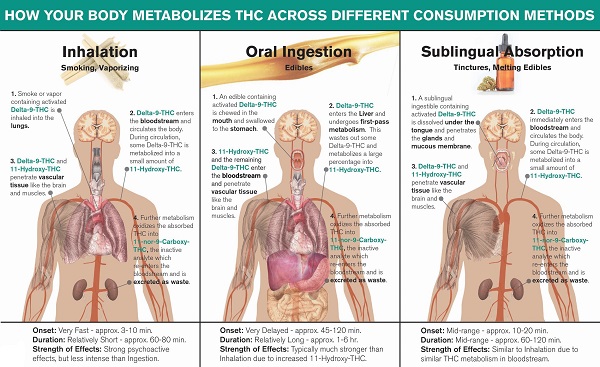
Understanding the various delivery methods of cannabis products is crucial before diving into the specifics of 11-Hydroxy-THC. Whether you’re using CBD, Delta 8 THC, or any other cannabis product, it’s important to recognize the different ways in which your body interacts with them, as these methods determine how cannabinoids are delivered to your system. These cannabinoids are the beneficial compounds that contribute to your overall wellness experience. Let’s explore the most common delivery methods for cannabinoids:
- Vaping and Smoking:
Vaping involves converting cannabinoid oil into a vaping solution, which is then heated and inhaled using a vape pen. Smoking, on the other hand, entails burning hemp flower in a rolled joint and inhaling the smoke. In both cases, the cannabinoids present in the vaping solution or smoke enter the bloodstream through the lungs, leading to an immediate effect felt throughout the body. However, the effects of vaping and smoking are relatively short-lived compared to other methods.
- Balms and Salves:
Balms and salves involve mixing cannabinoid oil with beeswax and other skin-enhancing ingredients. Users apply a small amount topically, rubbing it onto their skin. The skin absorbs the balm, allowing the cannabinoids to target specific muscles and joints. This method is particularly effective for localized areas and does not produce effects throughout the entire body.
- Edibles:
Edibles encompass a wide range of products such as tinctures, softgels, or gummies. These are consumed orally and undergo processing in the stomach and liver before entering the bloodstream. As a result, the effects of edibles take longer to manifest compared to inhalation methods. However, once the cannabinoids are absorbed into the bloodstream, the effects tend to last longer. Edibles offer sustained and prolonged effects, making them a preferred choice for individuals seeking a lengthier wellness experience.
By understanding the distinctions between these delivery methods, you can make informed decisions about how you want cannabinoids to interact with your body. While vaping and smoking provide immediate effects but shorter durations, balms and salves target specific areas, and edibles offer a longer-lasting experience. Now, let’s delve deeper into the specifics of 11-Hydroxy-THC and its role in cannabis consumption.
What is 11-Hydroxy-THC?
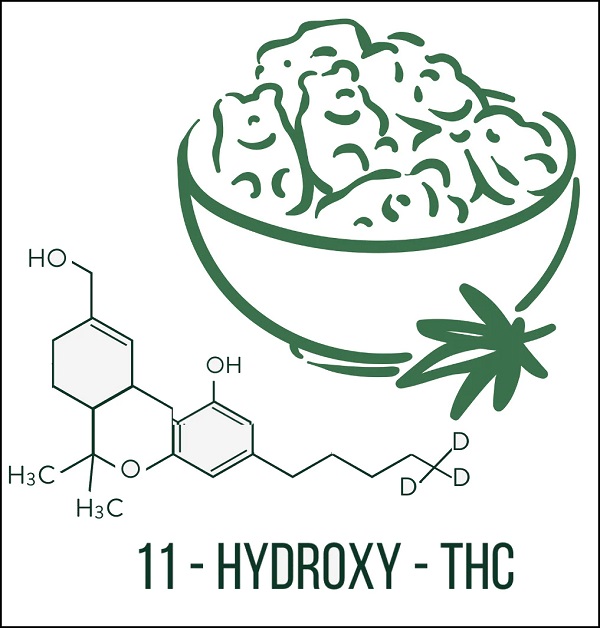
11-Hydroxy-THC, also known as 11-OH-THC, is a metabolite of Δ9-tetrahydrocannabinol (THC), the primary psychoactive compound found in cannabis. When THC is ingested, it undergoes metabolism in the liver, where it is converted into 11-Hydroxy-THC through a process called hydroxylation.
11-Hydroxy-THC is a structurally similar compound to THC, but it possesses distinct pharmacological properties and effects on the human body. It is believed to be more potent than THC, primarily due to its ability to cross the blood-brain barrier more efficiently, leading to enhanced psychoactive effects.
How does it affect the human body
Once 11-Hydroxy-THC is formed, it binds to cannabinoid receptors in the body, particularly the CB1 receptors located in the central nervous system. This interaction triggers a cascade of physiological responses, resulting in a range of effects on cognition, mood, perception, and motor function. The specific effects of 11-Hydroxy-THC can vary depending on factors such as dosage, route of administration, and individual differences in metabolism.
The formation of 11-Hydroxy-THC is a crucial step in understanding the pharmacokinetics and psychoactive potential of cannabis consumption. It helps explain why edible cannabis products, which undergo extensive first-pass metabolism in the liver, can produce different and often more potent effects compared to inhaling cannabis smoke or vapor.
Moreover, the distinct properties of 11-Hydroxy-THC have implications for medicinal applications of cannabis. Its potential therapeutic benefits include analgesic (pain-relieving), anti-inflammatory, and antiemetic (anti-nausea) properties, which make it an area of interest for researchers exploring cannabis-based therapies.
How to avoid consuming too much 11-Hydroxy-THC
Consuming an appropriate amount of 11-Hydroxy-THC, or any cannabis product, is crucial to ensure a safe and enjoyable experience. Here are some tips to help you avoid consuming too much 11-Hydroxy-THC:
- Start with a Low Dose: When trying a cannabis product that can lead to the production of 11-Hydroxy-THC, such as edibles, it’s advisable to start with a low dose. Begin with a small amount and gradually increase the dosage over time, allowing your body to adjust and gauge the effects.
- Read and Understand Product Labels: Carefully read the labels of cannabis products, particularly edibles, to determine the THC content and serving size. This information will help you estimate the potency of the product and consume it accordingly.
- Patience is Key: With edibles, it’s essential to be patient. The effects take longer to manifest compared to inhalation methods. Avoid the temptation to consume more if you don’t feel the effects immediately. Wait for the desired duration, typically 2-3 hours, before considering consuming additional doses.
- Allow for Metabolism Time: Recognize that the metabolism of THC into 11-Hydroxy-THC can vary among individuals. Factors such as metabolism rate, body weight, and tolerance levels play a role. Give your body enough time to process the initial dose before deciding whether to consume more.
- Avoid Mixing with Alcohol or Other Substances: Combining cannabis, including edibles, with alcohol or other substances can potentiate the effects and increase the risk of consuming too much 11-Hydroxy-THC. It’s best to avoid such combinations and maintain a clear understanding of the effects of cannabis alone.
- Seek Professional Advice: If you’re new to cannabis or unsure about appropriate dosing, consider consulting a healthcare professional or a knowledgeable budtender at a licensed dispensary. They can provide guidance based on your individual needs and help you navigate the consumption process.
Remember, the effects of 11-Hydroxy-THC can be potent and long-lasting, so it’s crucial to approach cannabis consumption responsibly and be mindful of your dosage. By starting low, being patient, and understanding your body’s response, you can enjoy the benefits of 11-Hydroxy-THC while minimizing the risk of consuming too much.
Summary
11-Hydroxy-THC offers an intriguing aspect of cannabis consumption. Its formation through the metabolism of THC and its increased potency compared to its parent compound make it a compound of interest. Understanding the differences in delivery methods, such as edibles, vaping, smoking, and topicals, is crucial to navigate the effects of 11-Hydroxy-THC responsibly.
By starting with low doses, being patient with onset and duration of effects, and being aware of personal tolerance levels, individuals can enjoy the benefits of 11-Hydroxy-THC while avoiding potential overconsumption. Responsible cannabis use, including awareness of product labeling and seeking professional advice, is essential for a safe and enjoyable experience.
As research continues to unravel the intricacies of 11-Hydroxy-THC, it holds promise for potential therapeutic applications and may contribute to advancing our understanding of cannabis-based therapies.
FAQ
Is 11-hydroxy-THC legal?
The legality of 11-Hydroxy-THC can vary depending on the jurisdiction and the specific regulations surrounding cannabis and its derivatives in that area. Since the legal status of cannabis and its compounds can differ from country to country and even within different states or regions, it is important to consult the specific laws and regulations of your location to determine the legality of 11-Hydroxy-THC.
In some places where cannabis is legal for medical or recreational use, 11-Hydroxy-THC may be included within the legal framework. However, it is crucial to note that certain jurisdictions may have specific restrictions or regulations regarding the use, possession, or distribution of any other cannabis-derived compound.
Why do people say the high from eating edibles is different?
The process of consuming edibles involves the ingestion of decarboxylated cannabis, which passes through the digestive system and liver before the cannabinoids are absorbed into the bloodstream. This process results in a higher conversion of THC to 11-hydroxy-THC (11-OH-THC), which is a more potent and psychoactive compound.
The higher levels of 11-OH-THC in the body can contribute to the perceived stronger effects experienced when consuming edibles compared to inhaling cannabis. The effects from edibles are often described as more intense and have a tendency to produce a “body high” that is deeply relaxing and sedating.
Why do cannabis edibles seem to have little to no effect on me?
There are several possible reasons why cannabis edibles may seem to have little to no effect on you. It could be due to individual differences in metabolism, incorrect dosage, tolerance to cannabinoids, unrealistic expectations, or interactions with food and digestive factors. To address this, consider starting with a low dose, adjusting the dosage based on tolerance, experimenting with different products, and seeking guidance from professionals if needed.

